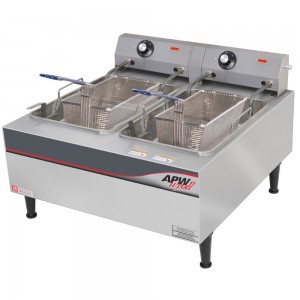 Most eateries, from food trucks to fine-dining establishments, rely on deep fryers as one of their main pieces of food equipment. Restaurants may have large commercial fryers for large quantities or even tabletop versions for cooking smaller items. Regardless what their needs are, restaurant owners have just a few basic options from which to choose. Here are the fundamentals of commercial fryers and how they work.
Most eateries, from food trucks to fine-dining establishments, rely on deep fryers as one of their main pieces of food equipment. Restaurants may have large commercial fryers for large quantities or even tabletop versions for cooking smaller items. Regardless what their needs are, restaurant owners have just a few basic options from which to choose. Here are the fundamentals of commercial fryers and how they work.
Main Model Types
There are a few different size options among commercial units. Here are the choices buyers will face at a restaurant equipment store:
- Countertop versus floor model? For small food items and a limited oil-holding capacity, a countertop model may be sufficient. Restaurants that feature French fries or several fried items on the menu will need something larger, such as a floor model.
- Electric or gas? Each has its benefits, but the main concern here is what type of fuel the restaurant has access to. If there are no gas lines to the building, electric is the obvious choice. Gas fryers are known to heat up more quickly, but electric versions have faster temperature recovery.
Different Fryer Formats
Again, fryers are fairly basic machines. There are really just four types of commercial units to choose from.
- Tube style: These machines cook heavily breaded foods but are tougher to clean because the heating tubes can’t be removed from the bottom.
- Open pot: Like tube-style units, these have an open oil compartment. However, they are most ideal for lightly breaded foods because debris from the cooking process can be difficult to remove.
- Flat bottom: These are designed to cook mainly foods that float near the surface. There is no mechanism in the bottom where sediment is meant to collect.
- Pressure: Particularly popular at restaurants that serve a lot of fried chicken, these fryers cook quickly and evenly in a pressurized chamber.
Parts of a Fryer
Many restaurant owners are able to maintain their machines fairly easily because there aren’t a lot of mechanical parts to replace. Here are the key parts of a commercial fryer:
- Heating element: Located right under the baskets, the elements heat the oil to frying temperature. Good quality elements can heat oil quickly. Many owners keep spare elements on hand in case one breaks.
- Control panel: This is the interface that the cook uses to set the oil temperature and to turn the machine on and off. Different oils have different smoke points, so individual adjustments may be needed.
- Thermostat: The mechanism that tells the element when to heat and when to turn off. This is another feature for which it’s good to have spares on hand.
- Others: Some fryers come with filters, but it depends on what type of configuration the equipment has. Some models also include lids, such as pressure fryers or open pot fryers that are covered when not in use.
Commercial fryers are essential to the operation of many restaurants, and it is worth careful consideration before choosing the best one. The options are not many, so adding one to a food establishment should be a quick and simple process.
Learn more
No matter if you are a Montreal restaurant like Toqué or a large university like McGill University, choosing the proper commercial refrigeration i ...
When you own a restaurant, you have a lot of things to take care of. There are a variety of tasks you must perform before the restaurant opens, so ...
By taking the right steps to improve your business’s energy efficiency, you can save money on your energy bills every month, and you can also do s ...
Many people are unaware there are kits that can coat various metals and make them stronger and more durable. These kits are invaluable to certain ...
When it comes to choosing your commercial cleaning company, there are a number of essential things to look for. We talk to "Vapor Clean", a leadi ...







